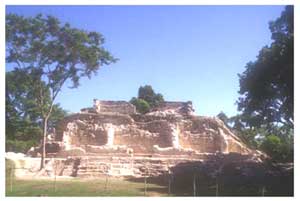| FAMSI © 2005: Jason Yaeger |
||
Revisiting the Xunantunich Palace: The 2003 Excavations
Research Year: 2003 Table of Contents
Abstract The Xunantunich Archaeological Project (1991-1997) excavated significant portions of the palace complex, including the ruler’s residence and adjacent structures. In 2003, the Xunantunich Palace Excavations program continued clearing the frontal terrace and lower building of Str. A-11, the ruler’s residence. This report synthesizes those two sets of data, with a focus on results of the most recent excavations. I use the data to reconstruct the occupation history of the palace and changes in access patterns and use of different structures. This in turn illuminates Xunantunich’s changing political organization. The palace complex’s simple layout and absence of features like a royal throne suggest that it housed an abbreviated elite court, politically dependent on another polity, likely Naranjo. The palace’s location at the cosmologically powerful northern edge of the site associated its residents with revered ancestors and the celestial realm, and the palace’s built environment created a series of architectural spaces that structured interaction between the polity’s residents and its ruling elite. Increasing restrictions to the ruling family over time reflects ideological changes that distanced ruler from subject, a trend paralleled elsewhere at the site. Roughly 75 years before the abandonment of Xunantunich, the palace’s residents vacated the complex, and it was partially dismantled, indicating a radical shift in rulership at the site. Durante el Proyecto Arqueológico de Xunantunich, Xunantunich Archaeological Project (1991-1997) se realizaron investigaciones en el complejo palaciego de Xunantunich, excavando un área amplia del palacio, que incluye la residencia de la familia gobernante de la ciudad y estructuras asociadas. En el año 2003, el programa "Excavaciones del Palacio Xunantunich", llevado a cabo bajo los auspicios del Proyecto de Desarrollo de Turismo, (Tourism Develoment Project) del Gobierno de Belice, dirigido por los Drs. Jaime Awe y Alan Moore, dio continuación a las excavaciones anteriores con el fin de revelar completamente el edificio inferior y la terraza frontal de la residencia del gobernante del sitio. Este informe presenta un breve resumen de los datos proporcionados por los dos proyectos, con énfasis en el trabajo más reciente. Los datos arqueológicos permiten una reconstrucción de la historia de ocupación del complejo palaciego, desde su fundación en la parte temprana de la fase Hats’ Chaak (670-780 d.C.) hasta su abandono en la fase Tsak’ (780-890 d.C.). Una aproximación más detallada de la evolución de los espacios del palacio y las actividades asociadas con ellos indica cambios importantes en el acceso al palacio y sus residentes, los cuales reflejan la historia política de la ciudad. El complejo palaciego de Xunantunich presenta una forma arquitectónica bien sencilla, sin evidencia de crecimiento significativo de sus estructuras. Este hecho, más otras observaciones como la ausencia de un trono y la ausencia de evidencia de producción artesanal asociada con el palacio, sugiere que el complejo no servía como la sede de una corte real, sino de una corte abreviada o truncada, la cual dependía de los reyes de otro reino, posiblemente Naranjo. La ubicación del palacio en el extremo norte del sitio señalaba la asociación de sus habitantes con antepasados sagrados y la zona celestial del cosmos. La arquitectura del palacio formó una serie de espacios que restringía y dirigía el acceso a la corte y el contacto con sus habitantes, definiendo así las interacciones entre el líder del sitio y sus sujetos. Con el tiempo, el acceso al líder se iba restringiendo cada vez más, sugiriendo cambios ideológicos que se ven en otras zonas del sitio de igual forma. El complejo palaciego se desmanteló y se abandonó, pero unos 75 años antes del abandono de otras zonas del sitio, hecho que sugiere que su abandono indica unos cambios significativos en la organización política de la ciudad. Click to download the report in PDF format: Revisiting the Xunantunich Palace: The 2003 Excavations (1.59 MB) The PDF files require Adobe Acrobat Reader.
Submitted 02/14/2005 by: |
||
| Return to top of page | ||
|
Text links to all pages at this site are available at the FAMSI INDEX |
||
